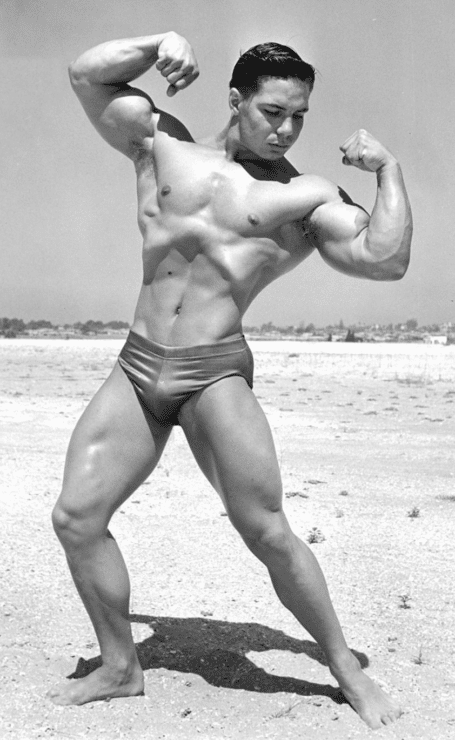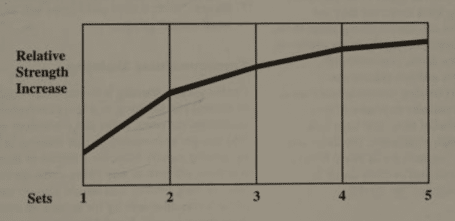Summary: According to modern research, 10-20 sets per muscle each week, if not more, is best for hypertrophy.
These factors however, done unusually, may reduce this need:
- longer interset rest
- longer intraset rest
- higher frequencies
- closer-to-failure sets
- moderate rep sets
- medium position exercises
Ultimately, so long as the number of sets you do allows progress in the long run, you are bodybuilding successfully!

Are Short Rest Periods Necessary?
I’ve done 3 working sets per exercise, once weekly, for most of my life. This isn’t much, yet I’ve always perceived each and every set as exhausting.
Others, especially the old-school champions I admired, seemed to tolerate far more volume without fanfare.
In bodybuilding circles, you often hear that 3-5 minutes between sets is on the long end. This would be on the short end for me though. When actually measuring it, I rest anywhere between 5-10 minutes!
Many bodybuilders, at least in the past, simply caught their breath or waited until their partners finished before going again. Vince Gironda even recommended advancing toward 10-15 seconds for his 8 sets of 8 reps protocol.
The exception for some bodybuilders seems to be 3-5 minutes for heavy compound movements like dead-lifts with lower reps.
However, Steve Reeves mentioned that he’d reduce the weight to maintain his rep range. Popular modern systems like Reverse Pyramid Training (RPT) account for this as well, reducing weight by a percentage on latter sets.
Despite much bodybuilding lore supporting brief rest periods, a recent study has shown that longer rest periods drive additional muscle growth for the same number of sets. This makes sense because you have a greater volume load (weight x reps x sets), all else being equal.
My style came to me simply because it never felt natural, to me at least, rushing between sets. (This doesn’t mean my approach is better… more on this at the end.) However, this does explain partially why each set feels so draining… I’m using heavier relative loads.
I still bring an intense desire to improve. This means 8-15 reps across with slightly more weight, maybe just half a pound, compared to last session. On the whole, I’ve made good progress over my lifetime compared to the average trainee.
Others training with fewer sets have clearly succeeded like Clarence Bass or Wilfried Dubbels.
Finally, I notice that quite a few popular routines, such as Wendler’s 5-3-1, go fairly low as well.
If this assumption is reasonable, that more rest allows greater intensity and therefore demands less volume to stimulate growth, then what factors could reduce this need?
Factors
It really boils down to this: that all life is interrelated. We are all caught in an inescapable network of mutuality, tied into a single garment of destiny.
– Martin Luther King Jr.
Longer Interset Rest
As described already, longer rest periods between sets allows more weight & reps given the same number of sets.
Longer Intraset Rest
Don’t forget that rest between reps should mean less volume needed too.
The famous 20-rep squat, done rest-pause style for only a single set, was (and is) highly effective.
You take a weight you may normally get 6-10 reps with continuously. Then, with as long as needed between reps yet maintaining a standard like keeping the barbell on your back, you ensure more than several challenging reps.
Beyond the extreme nature of squatting this way, any time you take a break, say to pause at lockout on a bench press to prepare for that final rep, fewer sets may be needed.
Higher Frequencies
For the same number of sets, you will perform better with higher frequency per exercise, due to less done per session.
However, I’d argue that, for myself and others that train similarly, 5-7 days between exercises is more conducive to exerting the utmost effort.
Closer-to-Failure Sets
Training closer to positive failure, if not reaching it on every set, should mean fewer sets needed.
Worth noting is that reaching failure is subjective.
Advanced trainees are known to work harder than novices or intermediates due to experience. While beginners tend to respond to anything & everything, this could still mean that longtime bodybuilders get more out of less volume than say intermediates.
Nonetheless, training to failure is a step along the right process. It could overburden the nervous system when done excessively and isn’t required if progressive overload is happening. However, it will undoubtedly occur throughout your quest to grow.
(Oddly enough, it’s vital in the sense that what you are feeling actually leads to adaptation as you grow stronger!)
Moderate Rep Sets
The fatigue experienced here seems ideal to maximize full motor unit recruitment without anything else limiting you, hence why 8 reps seems like the perfect rep count.
Medium Position Exercises
A typical chest routine involves a flat press, an incline press, and either a decline press or parallel bar dip, with flyes at each angle as possible substitutions.
Yet perhaps you may circumvent them all through a low incline or very wide flat press with the bar aligned higher on your chest. (At least in this case, this strategy may be harsh on the shoulders.)
These exercises may not be efficient in opposing the fibers. However, they are efficient for bodybuilding; this mechanical wastefulness doesn’t matter for our purposes.
In theory, you’d need fewer sets since you’d stimulate more fibers at once.
Reducing the Need for More Sets?
When every workout is like a powerlifting meet and you set out to achieve your goals and maybe even surpass them, something’s got to give.
– Dorian Yates
A low-volume, high-intensity approach isn’t necessarily better.
Both lifting heavy weight and fighting the burn can lead you down the same path activating high-threshold motor units, which control the fast-twitch muscle fibers, so long as you approach failure with loads above 30%.
The catch with heavy poundage, as Dorian states, is that every set requires great concentration. Distraction for just a moment may cause injury or reduce growth potential.
Within a given time limit, you could also increase volume if willing to push yourself. This seems to be what Gironda aimed to achieve through high-density training. The assumption that more rest is better only holds true with the same number of sets.
Nonetheless, low volume is efficient and can be pursued sensibly by avoiding explosive movement and warming up sufficiently.
Strength isn’t perfectly correlated with size but muscle volume certainly determines max force output. If you are getting stronger, then your training works!
Therefore, I’d suggest individualizing the number of sets you apply by evaluating progress, considering an increase as needed.
It’s problematic to calculate volume anyway… a set of underhand pull-ups doesn’t work the biceps well.
Unlike in HIT philosophy, if you reach a standstill, I would definitely consider doing more since multiple sets are superior to single sets.
Advanced techniques like drop sets or negatives, often applied by those doing HIT, just add volume in the end. Why else would moderate-rep sets work better than a single 1-RM to failure?
No matter how we cut it though, lower volume could be suboptimal. Yet, as Clarence Bass says, adhering to a program in the long run matters the most. Steady beats sporadic progress.
So how many sets are needed for successful bodybuilding? Unfortunately, the research only provides a sound basis if you train that way. If you train like me, with more rest in various ways, why not start with 3 working sets and see how that goes?

If you ponder how many workouts you’ll have over a lifetime, you soon realize that any progress is exceptional… and these factors may validate fewer sets for successful bodybuilding.
